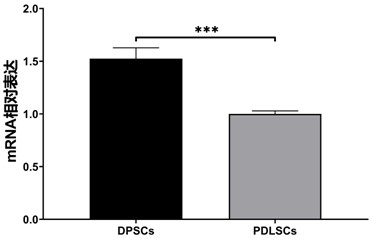Application of HS90A as marker for identifying dental pulp stem cells and periodontal ligament stem cells, and kit and method for identifying dental pulp stem cells and periodontal ligament stem cells
A technology for periodontal ligament stem cells and dental pulp stem cells, which is applied in the field of kits for identifying the two, can solve the problems of difficulty in distinguishing between the two cells by morphological and surface characteristics, and does not express hematopoietic stem cell markers, and achieves a wide range of clinical applications. , suitable for promotion and application
- Summary
- Abstract
- Description
- Claims
- Application Information
AI Technical Summary
Benefits of technology
Problems solved by technology
Method used
Image
Examples
Embodiment 1
[0081] Example 1 Screening of dental pulp stem cells and periodontal ligament stem cell markers
[0082] 1. In this embodiment, dental pulp stem cells and samples from three different groups of individuals and corresponding samples of periodontal ligament stem cells were used. The whole protein of the cells is dispersed in the hydration solution, and then the first phase is carried out in the Immobiline DryStrip gels (24cm, pH3-11) strips for the initial separation of the proteins in the IPG focusing system. A second phase of protein redistribution was performed on 10% SDS-PAGE. Protein spots were excised, reduced and alkylated in DTT and IAA, respectively, and then digested into peptides in trypsin. Peptides were redissolved in dispersant, detected in MALDI-TOF-MS and identified in MASCOT.
[0083] 2. Experimental results
[0084] After the two-dimensional electrophoresis results are stained with Coomassie brilliant blue, spot detection can be performed from the results of th
Embodiment 2
[0085] Example 2 Identification of identification markers for dental pulp stem cells and periodontal ligament stem cells
[0086] 1. Extraction of total RNA from dental pulp stem cells and periodontal ligament stem cells
[0087] In this embodiment, dental pulp stem cells and samples and corresponding periodontal ligament stem cell samples from 5 different individuals were used.
[0088] 1) Pour off the medium in the petri dish / bottle, wash with PBS 2-3 times, add Trizol solution, transfer to a 1.5 mL centrifuge tube, then add 0.5 mL Trizol to the petri dish to rinse the petri dish and harvest the remaining incomplete blown scattered cells.
[0089] 2) Add 200 μL of chloroform directly, vortex for 15 s to mix well, and then place at room temperature for 2-3 min.
[0090] 3) Centrifuge at 12000 rpm for 20 min at 4°C.
[0091] 4) After centrifugation, the mixture is separated into three phases, and about 400 μL of the upper aqueous phase is transferred to another centrifuge tu
Embodiment 3
[0104] The method used in this example is the same as that in Example 2, the only difference is that primers 1-6 are used to detect the HS90A gene in the samples. The primer mixture contains the primers of the internal reference gene shown in SEQ ID NO: 13-14 and the primer shown in SEQ ID NO: 1-2 (primer 1), or SEQ ID NO: 3-4 (primer 2) The primer shown, or the primer shown in SEQ ID NO: 5-6 (primer 3), or the primer shown in SEQ ID NO: 7-8 (primer 4), or the primer shown in SEQ ID NO: 9-10 (primer 5) , or the primers shown in SEQ ID NO: 11-12 (Primer 6), wherein the concentration of all the primers is 2 pmol / µl.
[0105] result:
[0106] Primers 1-6 can be amplified normally, but the efficiency of amplification is different, and the time to reach the plateau first is different (such as Figure 5 shown). It can be seen from the dissolution curve that different primers exhibited different dissolution states during dissolution, among which primer 1 performed the best, showing
PUM
 Login to view more
Login to view more Abstract
Description
Claims
Application Information
 Login to view more
Login to view more - R&D Engineer
- R&D Manager
- IP Professional
- Industry Leading Data Capabilities
- Powerful AI technology
- Patent DNA Extraction
Browse by: Latest US Patents, China's latest patents, Technical Efficacy Thesaurus, Application Domain, Technology Topic.
© 2024 PatSnap. All rights reserved.Legal|Privacy policy|Modern Slavery Act Transparency Statement|Sitemap



